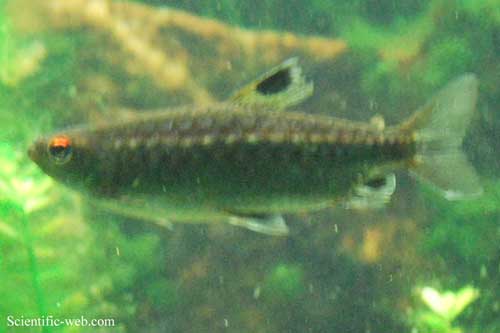
Arnoldichthys spilopterus, Photo: Michael Lahanas
Superregnum: Eukaryota
Cladus: Unikonta
Cladus: Opisthokonta
Cladus: Holozoa
Regnum: Animalia
Subregnum: Eumetazoa
Cladus: Bilateria
Cladus: Nephrozoa
Superphylum: Deuterostomia
Phylum: Chordata
Subphylum: Vertebrata
Infraphylum: Gnathostomata
Megaclassis: Osteichthyes
Superclassis/Classis: Actinopterygii
Classis/Subclassis: Actinopteri
Subclassis/Infraclassis: Neopterygii
Infraclassis: Teleostei
Megacohors: Osteoglossocephalai
Supercohors: Clupeocephala
Cohors: Otomorpha
Subcohors: Ostariophysi
Sectio: Otophysa
Ordo: Characiformes
Familia: Alestidae
Genus: Arnoldichthys
Species: Arnoldichthys spilopterus
Name
Arnoldichthys spilopterus (Boulenger, 1909)
Synonyms
Petersius spilopterus
Vernacular names
Deutsch: Großschuppensalmler, Arnolds Rotaugensalmler
Arnoldichthys spilopterus, the Niger tetra, is a characin endemic to Nigeria. It is the only member of its genus.
Description and ecology
Arnoldichthys spilopterus is a tropical freshwater species found only in a limited number of locations in Nigeria (Ogun and Niger rivers).[1] Males are on average 9.6 centimetres (3.8 in) long. Its diet consists of worms, insects, and crustaceans. Females in captivity can lay about 1,000 eggs, which hatch within 30–34 hours.[2]
Conservation
This species is currently classified as endangered by the IUCN due to its limited range coupled with losses to the aquarium trade and ongoing habitat degradation.[1]
References
Olaosebikan, B.D.; Lalèyè, P. (2020). "Arnoldichthys spilopterus". IUCN Red List of Threatened Species. 2020: e.T182186A134739812. doi:10.2305/IUCN.UK.2020-2.RLTS.T182186A134739812.en. Retrieved 20 November 2021.
Froese, Rainer; Pauly, Daniel (eds.) (2015). "Arnoldichthys spilopterus" in FishBase. 9 2015 version.
Retrieved from "http://en.wikipedia.org/"
All text is available under the terms of the GNU Free Documentation License

